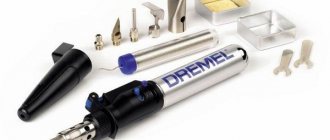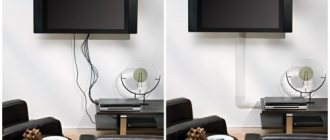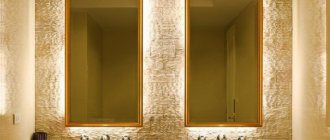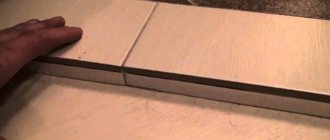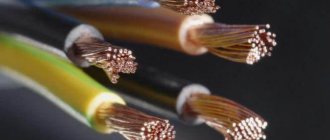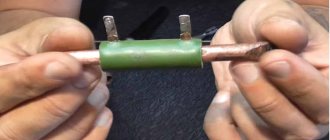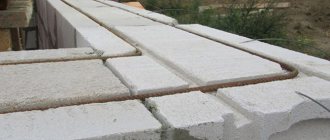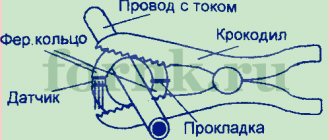Probes are an integral part of all multimeters, which comes complete with the measuring device, regardless of its model. Good probes have been performing their task well for many years. But it also happens that a few days after purchasing a multimeter, one or even both contacts fail due to a broken wire, broken tip or cracked insulation. To protect yourself from such a nuisance, you need to purchase high-quality and reliable multimeter probes, with good wires and durable tips. Many people prefer to make them themselves. In this material we will talk about the varieties and features of these elements, and also figure out how to make homemade probes for a multimeter.
Universal probes
These products are the simplest and cheapest. They are included with most inexpensive multimeter models. The cables of these elements are equipped with PVC insulation, and the plugs and lug holders are made of plastic. A thin wire is attached to the steel electrode from inside the holder. Such tips can easily come off if not handled carefully. It is clear that there is no need to talk about durability and high reliability here.
Different models of universal contacts have unequal lengths of the central electrode of the plug and the protruding part of its body. They also differ in the mounting depth of the plug.
Review of two types of multimeter probe clamps
Good day to all! It is difficult to translate the name of these things into Russian, so I will call them clamp probes. There will be two different types in the review: ready-made probes with banana connectors for use, for example, with a multimeter, and separate clamps of a slightly different design.
Below the cut there are a lot of pictures, videos of work, small tests and the final verdict :)
According to tradition, for those who are in a hurry, the probes in the picture are quite good. But the second product (separate clamps) is so-so, I think it will be inconvenient for constant work. Because Using standard probes with needles is not always convenient, so I decided to upgrade my tools and ordered these clamps. In addition, they can still be used, not only for measurements. For example, to connect a laboratory power supply.
General view of the multimeter probes:
Closer view of the clamp in open and closed state:
Banana connectors:
The wires in the probes seemed a little flimsy to me and did not inspire much confidence. For comparison next to relatives from VC99:
In the following photographs you can evaluate the internal structure, conductor cross-section and mediocre soldering quality:
The multimeter itself shows the internal resistance of the probes on the edge between 0 and 0.1 ohm:
Measuring the resistance of a 0.1ohm resistor:
Next comes a capacious electrolyte with a declared capacity of 2200 microfarads. By the way, my multimeter is very slow to understand such values, so such probes are especially relevant:
More detailed examples of what clamped resistor leads look like:
Appearance and operation of the mechanical part in the video:
That's all for now with the first product; conclusions will be collected at the end of the review.
For now, I’ll move on to criticizing the second product, individual clamps.
The first thing I didn’t like was that the seller sent them all the same color, although the colors on the product page were different.
In bulk:
General view, larger:
The rear cap is removed to reveal the internal structure:
It is not possible to use standard wires that are used with Bradboards. This involves soldering a separate wire, apparently to the rivet.
Next, for scale, a clamp next to the microcircuit with a pin pitch of 0.8mm:
You can get hooked, but on a powered board there is a high risk of shorting adjacent pins.
For example, on a regular connector with a pitch of 2.5mm, and a transistor in an SOT-23 package. No problem here:
On a microcircuit with a smaller pitch (~0.42mm) there is almost no chance:
Finally, also the appearance and operation of the mechanical part in the video:
What do we have in the end?
I definitely recommend the multimeter probes; I got exactly what I expected. Almost irreplaceable item. I don't think you can find better quality for the price. At the time of purchase they cost around 150 rubles. It's a little cheaper now.
You can probably find better clamps. I didn’t like the fact that they all arrived the same color and required soldering. They jam when moving.
Branded products
The multimeter can have a probe made of various materials. High-quality and reliable contacts can be distinguished by the following characteristics:
- Multimeter probe leads are made of highly flexible material.
- The holder insertion is flexible and sealed. The vein in it holds tightly and does not give in to random jerks.
- The surface of the product near the base of the holder does not slip and can be comfortably held with your fingers during measurements. The best option is a holder with a rubberized surface.
The video shows an example of such products:
Silicone probes have all of the above properties. These parameters are responsible for the high popularity of such products.
Often the holder inputs are made of plastic, but in this case they must have special recesses, otherwise the element will not have the required flexibility. On almost all branded models, plugs and electrodes are equipped with caps that protect the elements from contamination and minimize the possibility of puncture injuries.
These products were developed taking into account the experience of using earlier models, and therefore are distinguished by their thoughtfulness and ease of use. The wire of such contacts has sufficiently high strength and flexibility, is resistant to accidental jerks and does not crack when bent.
How to choose
There are no exact criteria for how to choose probes, since they usually come with a multimeter. However, you can evaluate budget and professional models and draw a conclusion based on the information received.
Budget models have measuring probes with PVC insulation, plugs and holders made of plastic. They have a standard thickness of 4 millimeters. Length varies depending on which model. There are several options in terms of shape, but due to a minor design feature, it cannot be said that they are unreliable.
The products are impractical due to the fact that any careless movement can tear off the tip. In addition, the shape of the wound wires remains the same as when wound. They have low heat resistance and unreliable insulation, which can be damaged with a soldering iron. In addition, the measuring wires for the multimeter become stiff in cold weather and crack.
Note! Budget models are generally not multifunctional. For example, to measure electronic boards with SMD components, you need to take products that have a fine structure.
Budget models are good only in that they are cheap. However, they cannot be used for a long time. In addition, they are also not used at a professional level.
Professional models have many positive qualities. The wires have silicone insulation and are flexible and thermally resistant. Holders with a plug have flexible sealed inputs and ends, which is why the wires will not be damaged in a casual market.
You might be interested in this Features, purpose, design and principle of operation of the diode
The needles of professional products are equipped with special protective caps that are removed during use. They allow contacts to remain uncontaminated and significantly reduce the risk of puncture injury. In addition, the electrodes are gold-plated and anodized, with an internal resistance of about 0.04 Ohm.
Note! Therefore, it is necessary to select probes for a multimeter based on material, flexibility, heat resistance, insulation reliability, the presence of protective caps and low internal resistance.
It also makes sense to look at the disassembly of the products.
Probes for SMD mounting
When working with SMD elements, it is periodically necessary to carry out measurements, which can only be done using thin probes connected to the tester. These products are equipped with sharp brass or stainless steel needle-shaped tips. They are necessarily protected with caps, which minimize the risk of electrode fracture or accidental injury to the technician.
For SMD installation specialists, such elements are most convenient to use. With sharp probes you can not only pierce the wire insulation, but also scrape off the solder mask from the desired area of the board surface and then carry out measuring work. Although the thickness of this needle is very small, the element can easily withstand a voltage of 600 V for a long time.
For measuring work when installing SMD components, multimeter probes are also provided. They allow you to measure the required parameters of a part both on the desktop and directly on the board.
During the measurement, the component is clamped with pliers, which guarantees the quality of the contact. These products have a fairly short cable, but a long one is not needed to work with SMD.
If the measurement process requires maximum care to prevent the electrode from touching other parts, then it is best to use probes with holes at the ends.
With their help, you can take measurements both on printed circuit boards and during electrical installation work, without fear of accidentally causing a short circuit.
Varieties
Probes are divided into budget and professional models, plastic and silicone. Test leads are also available with a spring-loaded hook, an alligator clip, and an attachment with a terminal adapter. There is also a generally accepted classification of test leads. It is shown below.
Universal
Universal type test leads are the simplest and cheapest. They come with most inexpensive measuring devices. They have an unequal length of the central plug electrode and a protruding body part. They differ in that they have different mounting plug depths.
Universal products
Branded
Branded probes are distinguished by increased reliability and high quality. They are made from a material that is highly flexible. The holder insertion is flexible and sealed. Its veins were strong, and unyielding due to random jerks. The surface of the base product is non-slip and can be easily held with your fingers when taking measurements.
Often branded products are made of plastic, but then they are equipped with special recesses. Almost all models have caps that protect the probes from dirt and dust. In addition, they allow you to protect your fingers while working with the multimeter. The products are comfortable and well designed. The wires are so high-strength and do not crack when bent.
Branded products
For SMD mounting
Probes for SMD mounting are products that have sharp brass or stainless steel needle tips with caps, thanks to which the user will not receive microtrauma if the electrodes are broken. Sharp probes are intended not only for puncturing wire insulation, but also for scraping off the solder mask during further measuring work. Despite the fact that the probes have a small needle, they can withstand a voltage of 600 watts.
Note! It is worth noting that there are pliers for SMD mounting of a multimeter. Using them, you can carry out the necessary measurements of parameters, both at work and on the board. When taking measurements, the component must be compressed using pliers to ensure good contact. Such products have a fairly short cable. When working, you need to work with the forceps as carefully as possible. Otherwise, you may damage them. They are designed for measurements on printed circuit boards and electrical installations.
You might be interested in Features of an electrical energy generator
For SMD mounting of the product
With various attachments
Today, probes with various attachments are especially popular on the market. Their sizes vary, but in any case, each probe has a reliable dielectric shell. It is important that such devices make it possible to significantly simplify the measurement process, since the master can choose an attachment for a specific device and screw it into the multimeter. Interestingly, each nozzle is produced separately.
With various product attachments
Silicone probes
Silicone probes are convenient, practical measuring tools that are available in both large and small sizes. The latter are designed for compact multimeters. These probes are suitable for devices from any manufacturer. Their length is no more than seven millimeters. These probes are safe to work with. There are no accidental short circuits during measurements. To avoid kinks and chafing of the wires, they are sealed and flexible at the input. It is worth noting that thanks to silicone as a material, their service life is longer than that of other models.
Silicone probes
Crocodile tips
This version of the tip is also available on the modern market and is in considerable demand. In some cases, it turns out to be preferable to sharp electrodes. The size of the “crocodile” may vary, but in any case it must have a reliable shell made of dielectric material.
Connecting tips can be made in the shape of “crocodiles” and are used as an additional element for a standard probe. Often, the kit for the multimeter includes tips in the form of clip-on “crocodiles”, which, if necessary, can be either detached or attached.
It is also necessary to mention the kits, which include several different tips. When starting work, the master himself selects the one he needs and screws it in like an attachment. This feature allows in some cases to significantly simplify the measurement process. So, for example, a crocodile can be connected in turn to different sections of the electrical circuit being tested, while the other tip is attached to ground as a terminal.
Technicians who work with terminal components prefer terminals designed in the form of clips and hooks. With the help of such elements it is convenient to carry out measuring work on printed circuit boards, as well as to hold the terminal components in place during measurements. These tips, as well as needles and crocodiles, can be included in the delivery package.
Available silicone probes from Ali. Cheap, but is it cheap?
A quick overview of sharp, thin multimeter probes with silicone leads. In my search for affordable probes with silicone wires, I came across the cheapest ones (at the time of ordering I couldn’t find cheaper ones), at least silicone was stated both in the description and in the reviews. While trying to find out the wire parameters from the store, I suddenly received an offer to buy a sample, paying only $1 for delivery, and then provide feedback on the quality. The store didn't ask for a review, but I decided to share. Moreover, I received it with really silicone wires (the test and the lighter passed). That's it in a nutshell. And for photos, details and minuses found, please see cat. UPDATE:
Unfortunately, after the review was published, the seller raised the price to $4. But he regularly organizes promotions. After 8 days, the price is again low, as during the sale - $3.08.
A small retreat
Having broken the connector of the supplied PeakMeter probe, in addition to repairing it, I was puzzled by finding a second set with thin needles.
In general, I am not an “electronics engineer” in any way, and in everyday life I have enough of the simplest probes. But the convenience of a silicone wire in a soldering iron and a series of reviews by the respected uncle_sem, in the comments of which many copies were broken about silicone, prompted me to look for options with just such wires. Moreover, not having a professional need for expensive and high-quality probes, I looked for the most affordable options. So the store’s offer of a sample simply hit the spot. We can say that my review is a kind of antagonist to uncle_sem’s reviews under the motto “I want silicone cheap.” And a little about silicone from a layman’s point of view. In the process of searching, I pretty much tormented several Muskovites with questions. I made some conclusions for myself about the wire options that can be found in “silicone” probes from China. Moreover, even in expensive sets the expected insulation on the wires is not always found. Point 18 limits me to links to other products, so there will be no links, only conclusions: 1) Ordinary PVC insulation. Despite the seller’s statements that they have silicone or “PVC silicone”, this is ordinary PVC, it tarnishes in the cold, and cannot withstand hot temperatures.
I made some conclusions for myself about the wire options that can be found in “silicone” probes from China. Moreover, even in expensive sets the expected insulation on the wires is not always found. Point 18 limits me to links to other products, so there will be no links, only conclusions: 1) Ordinary PVC insulation. Despite the seller’s statements that they have silicone or “PVC silicone”, this is ordinary PVC, it tarnishes in the cold, and cannot withstand hot temperatures.
2) Insulation made from “under-silicon”, let’s call it that, since the composition is unclear. These wires are flexible, they hold low temperatures well, remaining flexible, but they are afraid of a soldering iron. For example, there were some in this review.
3) Silicone insulation. Here are all the advantages of silicone - flexibility in the cold, they are not afraid of a soldering iron. There is a minus due to flexibility: because. Since probes and connectors are made of PVC plastic, the connection points, especially the entry points into the probe, can wear out, sometimes quite quickly. I'm judging by the reviews.
In addition, silicone wires come in two types - with a large number of very thin wires, more flexible, and also with thicker wires, the number of which is several times lower with the same cross-section, they are more rigid. I don’t know how to tell the difference. The second ones usually have full markings like VW-I SILICONE RUBBER 18AWG 200C 1000V. "But it is not exactly." This is a conclusion based on viewing a bunch of Ali lots with their parameters and reviews.
Stated characteristics
Materials:
silicone and gold-plated probe needle.
Length:
88 cm cable length (measured value 87 cm), total length 106 cm (measured value 107 cm).
Limits:
voltage up to 1000 V, current up to 20 A (probe marking CAT II 1000V 20A).
There is nothing to check the protection category and gold of the probe needle. But I seriously doubt that there is gilding here. 
The parcel took 5 weeks to arrive by Latvian Post. The track was tracked, but with a small number of intermediate points.
By and large, there is not much to write about probes. First, let's see what the sent probes look like.
The wire is very flexible, sometimes it seems even too flexible. The needles are made of yellow metal (or coated), moderately rigid, but you can bend them with your finger, although with a decent amount of effort. At the same time quite sharp. Leather can be pierced easily, as can insulation, so be careful. For this reason, I did not cut off the protective caps. I'm guessing some version of bronze is being used here. The needles are quite convenient for working with small contacts.
“Bananas” are cut, made from a single rod. I was pleased that they are inserted quite tightly into the multimeter, they turn in the socket with difficulty, which means the contact is good.
Of course, the most interesting thing about these probes is what kind of sheath the wires have. First, test in the freezer. According to the refrigerator, it is -18, once the value measured by a thermocouple was -16..-17. After 1 hour and 15 minutes in the freezer, the wires did not lose their flexibility, so this test can be considered passed. Below there is simply nothing to freeze. Of course, the probes and connectors themselves are made of PVC, so they hardened as expected. Ordinary probes in the same freezer turn into hard plastic; it’s even scary to unbend them.
Next is a test with a soldering iron.
The seller guaranteed only 200 degrees Celsius, so I started checking from the lowest limit that I have - 200 degrees (measured value 205). I apply it, move it back and forth across the shell. Not a trace. Further upward 250-300-350-400 degrees (measurements of the tip with a thermocouple). Likewise. I apply the soldering iron tip to the shell, then move it slightly left and right for a couple of seconds. At 400 I noticed a slight “swelling”, just like with the silicone mat, but it immediately returned to normal as soon as I removed the soldering iron. Well, I decided to check the pile with a lighter. The flame temperature in the lower part is about 600-650 according to the thermocouple. But running a lighter along a wire does not leave any marks. Just a little soot if you linger a little and move it through the middle of the flame. A small comment.
I'm not sure that the lighter test is indicative. After I recorded the video, I tried a similar action on twisted-pair wiring in polyethylene insulation. Several passes with a lighter and they left no marks on it. To start melting, even burning, you need to hold it for 2-3 seconds without a break. But a regular PVC-insulated wire does not pass the soldering iron test accurately.
Another interesting parameter is resistance. On my instruments there are zeros (although, for example, for the supplied PeakMeter MS8236 probes it outputs 0.2-0.1 Ohm). I took the opportunity to measure at work using a more accurate device. The LCR meter showed a value of 80 mOhm for two probes. Indirect test by voltage drop: at a current of 5 A from a laboratory power supply, the voltage on one probe is approximately 185 mV, which corresponds to 37 mOhm at the probe. So the readings can be considered reliable; at least they reflect a qualitative characteristic.
The diameter of the core for clearance is around one millimeter. So we can assume a wire size of 18-20 AWG. This roughly corresponds to the obtained resistance value. A current of 5 A had no effect on the wire. I did not feel any heating when checking with a voltage drop; the current exposure lasted about 30-40 seconds.
Flaws
Naturally, the probes are not perfect.
Below I will list the points that I did not like. 1. “Noname” wire, without any markings at all. There are a couple of places where the shell is slightly uneven, to the point of nitpicking. I don’t know if the same wires are always used when making probes.
2. The wire is not fixed in the connector and in the probe. When bending, a gap is visible. Most likely, this is a consequence of the use of silicone; PVC does not fuse with the wire sheath during manufacturing. Theoretically, this increases the stress on the wire solder joint if the wire is accidentally pulled. But the gap is very small, so this is also more of a nitpick. It’s a little annoying to think that the wire slightly rubs against the PVC material of the probe during operation. And at the point where the probe enters, the wire can actually be damaged. There are such reviews about similar probes (for example, a fairly popular lot of similar probes with a photo with a lighter, which cost $4-$5).
3. The “tail” of the probes is not flexible. Ordinary, standard inexpensive probes. It would be much better if the wire input was designed in the form of a more flexible cuff, like the included Holdpeak probes:
Conclusions.
For their price, I consider the probes worthy of attention.
At least when choosing from budget ones. I think the disadvantage is that the stated parameters of the wire are up to 200 degrees Celsius, so it’s not a fact that in other batches the probes won’t have a different shell (that same “under-silicon”). But the reviews are positive so far. The workmanship is the usual standard inexpensive probes. Those. These are the same probes for $1-$2, only with silicone wire. I perceive these probes either as an option for a budget consumable for work, or as an option for a budget-conscious home craftsman.
PS: I did the review a little in a hurry, because... I had to postpone writing due to personal problems. But taking into account the fact that this product is also included in the sale, which began today, I decided to have time to write it, albeit in a crumpled form.
The product was provided for writing a review by the store. The review was published in accordance with clause 18 of the Site Rules.
How to make homemade probes?
As we said above, many people prefer not to buy new ones when factory probes break down, but to make them themselves. Let's consider two popular options for making homemade products.
Standard homemade probes
To make them you will need dismountable fountain pens (without refills) and dart tips for darts.
The operating procedure is as follows:
- Disassemble the fountain pens and try on dart tips for them.
- Having selected the appropriately sized components, insert the dart tips into the handles instead of the rods, after heating them with a gas burner.
- Place a piece of solder inside the handle, after moistening it with soldering acid and heating it.
- Place the cable there.
- Wait until the solder cools down and the probe elements are fixed.
For additional fixation, the dart tip can be glued.
The entire device is clearly shown in the video:
Thin homemade probes for piercing insulation
Now let's figure out how to make thin probes for a multimeter with your own hands. To do this, we will need collet pencils using replaceable leads, and sewing needles of suitable thickness.
The production of thin probes is carried out as follows:
- Solder the cables to the needles.
- Insert the needles inside the pencils until they hit the center of the collet. To prevent them from going inward when pressed, they should be glued into the collet.
- Solder the plugs to the cables.
It is advisable to apply colored heat shrink to the resulting products. When working with a hair dryer, you need to be careful, as the flow of hot air can cause deformation of the plastic.
Pen and pencil caps can be used as protective elements.
The video shows an example of making needle probes for checking small parts:
How to make it yourself
You can make the probes yourself, but many manufacturers of modern products do not recommend doing this, since every market model has been tested in practice, and homemade products may be unsafe. However, users provide detailed step-by-step instructions for creating homemade tips for multimeters and testers:
- Prepare materials in the form of dismountable automatic pens that do not have rods and dart tips for the game darts.
- Disassemble the automatic pens and try to check how the dart tips fit into them.
- Place the latter to the handle by hot welding with the addition of solder and soldering acid.
- Wait until the solder cools down and the probe elements are fixed.
- Use glue for additional fixation.
DIY product made from darts and handles.
At this point, the probes are ready.
There are also instructions for making homemade insulation piercing tips. To do this, you need to take collet pencil leads with sewing corners that match the thickness of the leads. The manufacturing instructions look like this: First, you need to solder the cables to the needles, then insert the leads into them. Then you need to solder parts of the plugs with colored heat shrink to the resulting cables. Use pencil caps as a means of protection.
You might be interested in the principle of operation of a thyristor, purpose and connection diagram
DIY product made from a needle and stylus
